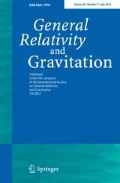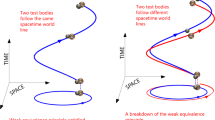Abstract
For a pair of twin Earth orbiting artificial satellites placed in identical orbits with supplementary inclinations, in addition to the sum of the residuals of the nodal rates, already proposed for the LAGEOS–LARES mission, also the difference of the residuals of the perigee rates could be employed, in principle, for measuring the general relativistic Lense–Thirring effect. Indeed, on one hand, the gravitomagnetic secular precessions of the perigees of two supplementary satellites in identical orbits are equal and opposite, and, on the other, the classical secular precessions induced by the multipolar expansion of the terrestrial gravitational field are equal, so that their aliasing effect cancels out in the difference of the perigees' rates. If the eccentricities of the two satellites would be chosen to be equal, contrary to the LAGEOS–LARES project, such cancellation would occur at a very accurate level. Among the time–dependent perturbations, the proposed observable would allow to cancel out the even and odd zonal gravitational tidal perturbations and some non–gravitational perturbations. With a proper choice of the inclination of the two satellites, the periods of all the uncancelled time–dependent perturbations could be made short enough to allow to fit and remove them from the signal over observational time spans of a few years. The linear perturbation induced by the terrestrial Yarkovski–Rubincam effect would affect the proposed measurement at a level well below 10−3.
Similar content being viewed by others
References
Sterne, T. E.1960). An Introduction to Celestial Mechanics, Interscience, New York, 206
Ciufolini, I., and Wheeler, J. A.1995). Gravitation and Inertia, Princeton University Press, New York, 498
Lense, J., and Thirring, H.1918). Phys. Z., 19, 156-163 (Mashhoon, B., Hehl, F. W., and Theiss, D. S., Trans.).
Lense, J., and Thirring, H.1984). Gen. Relat. Grav. 16, 711-750.
Ciufolini, I.Pavlis, E.Chieppa, F.Fernandes-Vieira, E., and Pérez-Mercader, J.1998). Science 279, 2100-2103.
Ries, J. C.Eanes, R. J., and Tapley, B. D.2003). In Nonlinear Gravitodynamics: The Lense–Thirring Effect, Ruffini, R., and Sigismondi, C. (Eds.), Proceedings of the First ICRA Network Workshop and Third William Fairbank Meeting, Rome and Pescara, Italy, June 28–July 4, 1998, World Scientific, Singapore, 201-211
Ries, J. C.Eanes, R. J.Tapley, B. D., and Peterson, G. E.2002). Proceedings of the 13th International Laser Ranging Workshop, Washington, DC, October 7–11, 2002 (http://cddisa.gsfc.nasa.gov/lw13/lw_proceedings.html#science).
Ciufolini, I.1986). Phys. Rev. Lett. 56, 278-281.
Ciufolini, I.1998). In LARES Phase–-A Study, Rome, 16-33.
Iorio, L.Lucchesi, D. M., and Ciufolini, I.2002). Class. Quantum Grav. 19, 4311-4325.
Iorio, L.2003). Phys. Lett. A 308, 81-84.
Iorio, L., and Lucchesi, D. M. (in press). Class. Quant. Grav. (gr-qc/0209027).
Iorio, L.2002). La Rivista del Nuovo Cimento 25, 63-68.
Iorio, L.2001). Celest. Mech. 79, 201-230.
Lucchesi, D.2001). Planet. Space Sci. 49, 447-463.
Lucchesi, D.2002). Planet. Space Sci. 50, 1067-1100.
Kaula, W. M.1966). Theory of Satellite Geodesy, Blaisdell, Waltham, MA, 124
Ciufolini, I.Chieppa, F.Lucchesi, D. M., and Vespe, F.1997). Class. Quantum Grav. 14, 2701-2726.
Iorio, L.Ciufolini, I., and Pavlis, E. C.2002). Class. Quantum Grav. 19, 4301-4309.
Iorio, L.2002). Phys. Lett. A 298, 315-318.
Author information
Authors and Affiliations
Rights and permissions
About this article
Cite this article
Iorio, L. On a New Observable for Measuring the Lense–Thirring Effect with Satellite Laser Ranging. General Relativity and Gravitation 35, 1583–1595 (2003). https://doi.org/10.1023/A:1025727001141
Issue Date:
DOI: https://doi.org/10.1023/A:1025727001141




